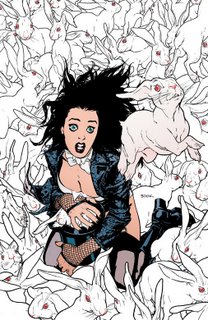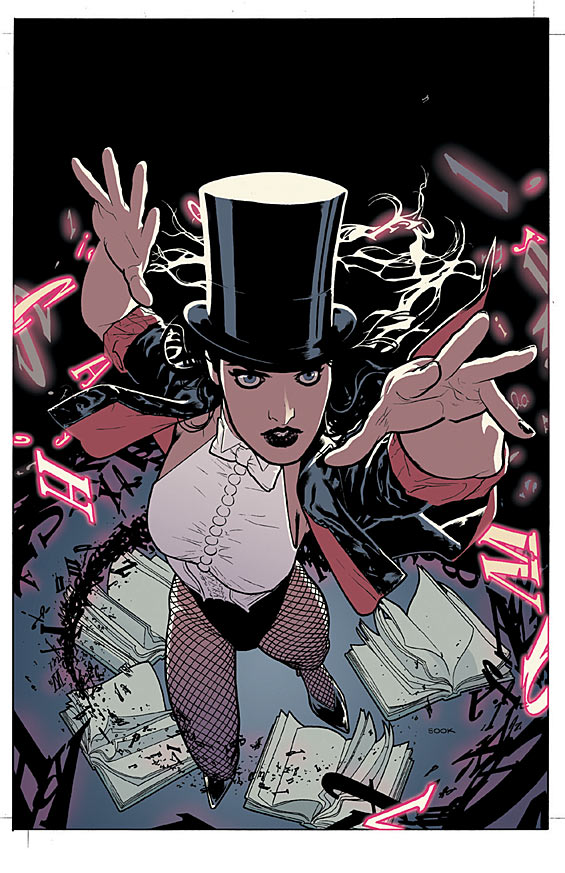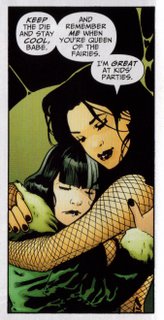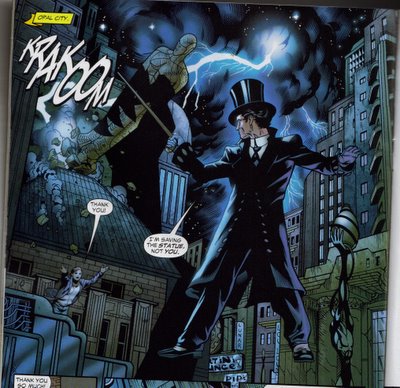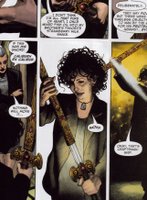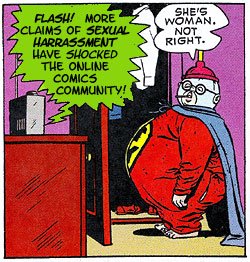Seven Soldiers: Shining Knight #4
My first thought upon finishing this comic was "I'd like to have Grant Morrison's baby."
Then I realized that would make me fat.
Seriously, though, this Seven Soldiers thing is that good.
Morrison throws a plot twist in there that I, as a major fan of King Arthur stories, have seen at least once (I believe more than twice, though) before, and I never saw it coming. But it makes perfect sense, and totally redefines how you consider the characters.
I liked Justin before, but was iffy if I wanted this new Shining Knight to replace the Golden Ager -- as I am not an advocate of killing off characters that were created before my parents, and killing off the Golden Age Sir Justin was likely if they had a replacement. And I liked seeing Sir Justin in Stars and STRIPE. He was pretty cool.
But after this twist is revealed, I say kill him, or freeze him in ice again, or drop him in the timestream. Push him to the sidelines again, because Morrison's revamp is the Shining Knight I want to see around.
I want to see Sir Justin in Wonder Woman! Right now! Kill Cassie or Donna (again) if you need to make room, but do so post-haste!
The above is from my first set of comic reviews. Yes, I have done them on this blog! In fact, the main reason I started this blog was to write the above review.
(I'm going to spoil the ending to Shining Knight #4 in a big way, so if you're waiting on the Trade, stop right here until you're done with Volume 2. I'm serious here. Big Warning.)
The basic plot of Shining Knight is this: Newly knighted Sir Ystin participates in the last battle of Avalon in the Castle Revolving against the Sheeda (Evil Fairy) Queen. He, carrying the King's sword Caliburn, falls into a flowing stream of water who turns out to be a gateway through time. He's plunged into a Modern City. Wierdness ensues. But, unfortunately, the Sheeda Queen is still alive and knows the young knight has that sword. So, she hunts him down and sets him against a corrupt Zombie form of Sir galahad, the Knight he squired for, for her amusement. During the battle, Ystin is revealed to be a female. The Queen laughs at her, but is distracted by other news. She leaves, ordering that Ystin be enslaved. Ystin kills Galahad, escapes, and sets out to kill the Wicked Queen.
You see, after I read Shining Knight #4 I hit the internet, eager for reactions to this revelation.
I was disappointed to say the least. Nobody else seemed to love it as much as I did. I felt a need to express my feelings.
I never once wondered what the "point" of the revelation was.
It had initially seemed to me to be a skillful way of highlighting Ystin's transformation over the series. I mean, internal change has happened. As of that battle, Ystin has accepted that there is no going back to Camelot, and has chosen to do what she can to help this world. This is a major character change, and he needed to ensure that it sunk in by making sure the Audience could never look at Shining Knight the same way again. What better way to do that than to reveal in the middle of a fight scene that the character is a different gender than they'd thought? It's guaranteed to change the viewpoint of the reader.
I also thought she was one hell of a character to add to the DC stable. Here is a time-displaced teenaged girl. Her origin is actually fairly simple to relate. She's distinctive in personality and interests from the other teenaged girl cliches we keep seeing. And, she's a brunette in a time of way too many blondes, so she'll be distinctive out of the armor.
But, a lot of people missed that. So, rather than just take my own enjoyment at face value, I found myself thinking carefully about the series itself.
It only enhanced my enjoyment when I reread it.
Knowing that Ystin was a girl, I noticed several things.
In the first issue, she finds a close female friend (Olwen) in the Sheeda lair. She attempts to help Olwen get free, only to be stabbed unexpectedly. Seems this was the woman she befriended at all, but a two-faced shapeshifter. She meets a twisted dead version of King Arthur himself. And of course, she meets the vicious Queen of Terror. A leering, scantily clad woman who would seem the ideal in feminine empowerment, as she's the ultimate ruler of her kingdom, but is in reality a corrupter and an exploiter of everyone and anyone she runs across. In the second issue, she falls prey to guilt and despair. Everything that has gone wrong is her fault and there's no place in this world. We see a prophecy by Morrigu that there would be an age where "women would be shameless, men strengthless." She meets a virtuous man who gives her some minor advice and then leaves to handle his own business. In the third issue she finally meets a pure-hearted woman, but this one wants to categorize her as a time-travel anomaly, and unwittingly brings disguised destruction with her.
In the fourth issue, all hell breaks loose. Her first love turns into a violent leering monster, her greatest secret is revealed to a crowd of spectators who are staring at her breasts, and there is blood everywhere.
At this point I stopped and thought to myself -- "Hey, wait a minute... This seems familiar."
"Aw, Hell!"
Yes, Ladies and Gentleman, Grant Morrison has managed to capture the experience of puberty for a young girl.
All of your female friends seem to become two-faced bitches who stab you in the back. All of your male friends turn into lewd brainless zombies who think of nothing but breasts. Older Men dismiss you. Older Women want to fit you into a potentially harmful little boxed personality. To top it off, your body has decided to completely betray you, becoming whatever shape is the least convenient for you, and an icky, disgusting embarrassing thing for about a quarter of each month.
So, what makes this a particularly feminine coming of age tale?
Well, there's the blood.
Particularly the feeling that everyone's attention is drawn to the blood.
Oh, and everyone's attention drawn to the breasts, also.
But most of all, it's what I mentioned above. Morrison clearly wanted us to never look at Ystin the same way again. Well, once puberty sets in, the change is far more drastic for young girls. Nobody ever looks at you the same. If you develop early, there's leering and jealousy. If you don't, there's an attitude that you are not good enough. You're no longer innocent after that age. You can't play with the same friends, or even the same games anymore. All of the adults you dealt with before react very differently to you. All of the rules have changed, right underneath you.
I never liked teenaged girl characters a lot. I despised both Wonder Girls, wanted to see the Spoiler killed, only knew PAD's twenty-something Supergirl, and could care less if Secret and Arrowette were dead or evil. Empress was cool, but that's more because she had smoky teleportation than because of her age and gender. I like Stargirl and Batgirl, but I wasn't even willing to give them a chance until after I turned twenty. I still have no attachment to Speedy, or anyone but Stargirl. And all of them, save Batgirl and Empress, look identical.
But I adore Shining Knight and I know I would have as a teenager. And I would've read her for the Camelot stuff.
Maybe it's personal. I'm fuzzy about a lot of "rites of passage" but I will always remember very clearly the first time an adult pointed out my breasts and told me to wear a bra, the first time a classmate pointed out my breasts, and of course, how big a jerk my first crush actually turned out to be.
So, everybody, get your soda cans, whiskey bottles, and water glasses handy and join me in a toast. Here's to a damn good mini-series, a wonderful new teenaged girl character, sixth grade, learning the truth about my first crush just in time, blood, training bras, tactless nurses who mean well, backstabbing girls who grow out of it, and wondering how the hell Grant Morrison knows what its like to become a young women.
